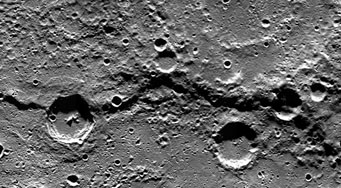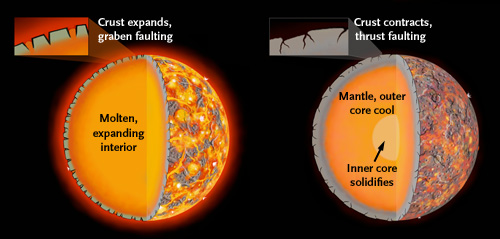As the innermost planet's interior cooled and contracted, its crust buckled and fractured just as much as geologists expected.

Victoria Rupes is a long scarp that formed when Mercury shrank slightly as its core cooled. "Rupes" on Mercury are named for ships of discovery; this one commemorates one of the ships used by Ferdinand Magellan to circumnavigate Earth in 1519–22. North is to the right, and the scene is about 150 miles (250 km) wide. Click on the image for a larger view.
NASA / JHU-APL / Carnegi Inst. of Washington
NASA's Mariner 10 spacecraft made three historic flybys of Mercury in 1974–75. Among the mission's many amazing results was the discovery that the innermost planet must have shrunk as it cooled after forming 4½ billion years ago. The evidence for that is a series of ragged thrust faults — places where one giant slab of rock has been pushed on top of another — due to strong compressional stresses within the crust.
Geophysicists quickly realized that Mercury is a "one-plate planet." It lacks the interlocking (and constantly colliding) patchwork of crustal plates found on Earth. Consequently, as Mercury's interior cooled and solidified over billions of years, its total volume shrank a bit. But by then the crust had long since solidifed — it had no "give" to give. So it responded by cracking and crunching, creating the thrust faults and wrinkle ridges seen in Mariner 10's images.
The same thing happens to an apple that's been sitting on the kitchen counter too long: it gets dried out, its volume shrinks, and its skin gets all wrinkly.

Global expansion (left) might have occurred early in Mercury's history, creating extensional stress in its crust. But as the planet cooled its entire globe shrunk slightly (right), which compressed the crust and triggered the formation of thrust faults like Victoria Rupes.
Don Davis / The New Solar System
Due to the peculiar coupling of Mercury's orbital and spin periods, Mariner 10 viewed less than half of the planet despite three passes.at close range. So researchers guesstimated, based on the faulting they could see, that overall the planet's radius had shrunk between 0.8 and 3 km. This result puzzled them, because calculations showed that the contraction should have been several times greater.
Now, thanks to NASA's Messenger spacecraft, geophysicists have global, high-def imagery that allows them to take a fresh look at the problem. In March 16th's issue of Nature Geoscience, published online, a team led by Paul Byrne (Carnegie Institution of Washington) reports that Mercury's radius has shrunk up to 7 km, much more in line with the theoretical prediction.

One of the most prominent shrinkage features on Mercury is this 1,700-km-long assemblage of lobate scarps and high-relief ridges. Geologists refer to this as a fold and thrust belt. The topographic map has been derived from Messenger's imagery and laser altimetry.
P. Byrne & others / Nature Geoscience
Byrne and his colleagues measured the crustal shrinkage two ways. First, they kept track of the thrust faults and wrinkle ridges spotted along eight "great circles" around the planet. This yielded a total radial contraction of between 3.7 and 5.5 km. (There's no good way to know at what angles the thrust faults extend down into the crust; shallower angles would cause greater overlap.)
The second method involved taking a complete census of the planet's contraction-induced ridges and fractures — 5,934 in all. After excluding territory covered by the large Caloris and Rembrandt impact basins, which postdate the era when Mercury cooled most rapidly, the team found that the radius had contracted anywhere from 4.7 to 7.1 km, again depending on the thrust-fault angles.
Either way, it's a solid match to the theoretical values. "That we have documented changes in Mercury's radius of up to a factor of seven larger than previous results resolves a nearly four-decades-old paradox," the researchers conclude, adding that "the history of heat production and loss and the accumulated global contraction are now consistent."
Other interesting tidbits emerged from this study. For example, the widespread volcanic plains near Mercury's north pole bear a disproportionate share of the wrinkle ridges and thrust faults. These plains cover only 6% of the planet, yet 28% of the counted features are found there and they account for 19% of the total shrinkage.
Also, because Messenger's laser altimeter has mapped the planet's highs and lows, Byrne's team found several instances where the regional topography slowly undulates, as if the crust has warped and buckled on larger scales.
Historical footnote: back in the 19th century, some scientists speculated that Earth's mountain ranges, tectonic rifts, and fault zones were created by the same kind of global contraction that's evident on Mercury. Now we know that it's all largely the result of plate tectonism, our planet's signature geophysical process.
Still, it's a reasonable scenario for what happens to rocky planets as they evolve. As Byrne and his team point out, "With the increasing number of terrestrial planets identified in extrasolar planetary systems, Mercury may come to serve as a case study with which to understand the global cooling and contractional histories of rocky, one-plate planets in general."
By the way, Mariner 10 will always have a special place in my heart. Its Mercury flybys were the first planetary encounters I covered after joining the staff of Sky & Telescope.
Reference:
P. Byrne et al., "Mercury’s global contraction much greater than earlier estimates" Nature Geoscience, published online March 16, 2014.
 0
0
Comments
You must be logged in to post a comment.